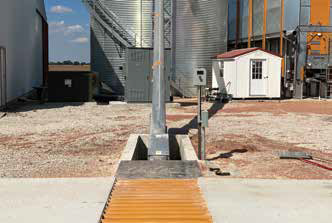Cost Per Bushel Analysis of Grain Conveying Systems for Corn
Published by The Grain Handling Direct Team - Powered by AI on May 22nd 2025

This report presents a comprehensive analysis of the average lifespan and cost per bushel for four types of grain conveying systems used for corn: augers, drag chain conveyors, belt conveyors, and round tube drag chain conveyors. Based on our research of university extension resources, manufacturer information, and industry publications, we found that belt conveyors offer the lowest cost per bushel at approximately $0.0132, despite having a higher initial investment than augers. This is primarily due to their significantly longer lifespan (3-4 times that of augers) and lower maintenance requirements.
Key Findings
-
Cost Per Bushel Ranking (from lowest to highest):
- Belt Conveyors: $0.0132 per bushel
- Auger Conveyors: $0.0255 per bushel
- Drag Chain Conveyors: $0.0263 per bushel
- Round Tube Drag Chain Conveyors: $0.0294 per bushel
-
Lifespan Comparison:
- Auger Conveyors: Approximately 1 million bushels before flighting replacement
- Belt Conveyors: 3-4 million bushels before belt replacement
- Drag Chain Conveyors: Estimated 2 million bushels (based on qualitative comparisons)
- Round Tube Drag Chain Conveyors: Estimated 2.5 million bushels (based on qualitative comparisons)
-
Initial Investment Comparison:
- Auger Conveyors: Lowest initial cost (estimated $15,000 for standard system)
- Belt Conveyors: Higher than augers (estimated $25,000)
- Drag Chain Conveyors: Higher than belt conveyors (estimated $30,000)
- Round Tube Drag Chain Conveyors: Highest initial cost ($12,000-$70,000, midpoint $40,000)
Research Methodology
Our research methodology included:
- Systematic review of university extension resources from MN, ND, SD, IA, and IN
- Analysis of manufacturer resources including grainsystems.com, brockgrain.com, sukup.com, and AGI Hutchinson
- Review of industry publications and third-party sources
- Synthesis of quantitative and qualitative data on lifespan and costs
- Calculation of cost per bushel using standardized methodology
- Validation of data accuracy and consistency
Detailed System Comparisons
Auger Conveyors
Advantages:
- Lowest initial investment
- Can handle steeper inclines (35-40 degrees)
- Require less length to reach the same height as belt conveyors
Disadvantages:
- Shortest lifespan (approximately 1 million bushels)
- Higher maintenance requirements
- More likely to damage grain
- Require about twice the engine horsepower of belt conveyors
Belt Conveyors
Advantages:
- Longest lifespan (3-4 million bushels)
- Lowest cost per bushel ($0.0132)
- Gentler on grain ("virtually no degradation of fragile products")
- More energy-efficient than augers
- High capacity (up to 12,000 bushels per hour for some field loaders)
Disadvantages:
- Higher initial investment than augers
- Limited to approximately 25 degrees incline
- Need to be 20-33% longer to reach same bin height as augers
- May require expensive covers and drip pans
Drag Chain Conveyors
Advantages:
- Gentler grain handling compared to augers
- Can discharge grain at multiple points along the conveyor
- Minimal maintenance when sized properly for the application
Disadvantages:
- Higher initial investment than augers and tube conveyors
- Higher horsepower requirements than bucket elevators or belt conveyors
- Length limitations (typically max 150 feet)
- More variability in manufacturing standards
Round Tube Drag Chain Conveyors
Advantages:
- Specifically designed for gentle material handling
- Dust-free enclosed system
- Durable stainless steel chain assembly
Disadvantages:
- Highest initial cost ($12,000-$70,000)
- Highest cost per bushel ($0.0294)
- Complex installation
- Requires regular maintenance of chain assembly
Calculation Methodology
To calculate the cost per bushel, we used the following formula:
Cost per bushel = (Initial investment + Installation costs + Lifetime maintenance costs) / Total bushels handled over lifespan
Where specific data was unavailable, we made reasonable assumptions based on qualitative comparisons from industry sources, clearly noting these as estimates. Full calculation details are available in the attached documentation.
Recommendations
-
For operations prioritizing long-term cost efficiency: Belt conveyors offer the lowest cost per bushel and should be considered despite higher initial investment.
-
For operations with limited capital: Augers provide a reasonable cost per bushel with the lowest initial investment, making them suitable for operations with capital constraints.
-
For operations handling delicate grains: Belt conveyors or round tube drag chain conveyors offer the gentlest handling, potentially preserving grain quality and value.
-
For operations with space constraints: Augers can achieve steeper inclines and require less length, making them suitable for operations with limited space.
Limitations and Further Research
This analysis is based on available data and reasonable assumptions. Actual costs may vary based on:
- Specific farm conditions and usage patterns
- Regional price differences
- Manufacturer variations
- Scale of operation
Further research could focus on:
- More specific pricing data for standard system configurations
- Detailed information on actual maintenance costs over time
- Field data on actual lifespans in bushels processed for drag chain conveyor systems
- Regional variations in pricing and lifespan
Conclusion
While belt conveyors offer the lowest cost per bushel for corn handling, the optimal choice depends on your specific operational needs, capital constraints, and priorities. Consider factors beyond cost per bushel, such as grain quality preservation, space requirements, and operational flexibility when making your selection.
All supporting documentation, including detailed research notes, calculations, and validation, is attached to this report.

